Nihon-sankei Aki no Miyajima Food The three most scenic spots in Japan


Since ancient times people have considered Miyajima sacred and have worshipped the island itself as a god. The main shrine is said to have been constructed in 593, the first year of Empress Suiko's reign. The first record of Itsukushima Shrine was alongside other famous shrines in the "Nihon Koki," a Japanese historical text dated 881. During the era of Taira-no-Kiyomori it became a place of worship for the Heike clan, and the main shirine building was constructed around 1168. As the power of the Heike clan increased, so did the number of worshippers at the shrine. It became known amongst the members of the Imperial Court. The Imperial Court and the emperor paid visits to the shrine. Bugaku, ancient Japanese court dance, also began during this period. Even after the fall of the Heike clan, the culture of the Heian period was warmly accepted by the Genji clan and the shrine continued to experience stability and prosperity.
Walking around, visitors can enjoy the different sights of Miyajima: the Edo period atmosphere of Machiya-dori, the seasonal, changing colors of the trees in Momiji-dani Park, and the hiking routes of Misen. Shops offer a local specialty, momiji manju (sweets shaped like maple leaves), as well as a variety of Seto Inland Sea marine products.
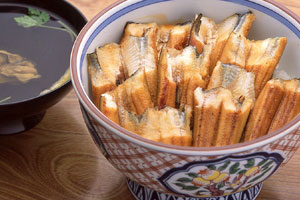
Onoseto-grown conger eel, or anago, is characterized by its full-bodied flavor and soft texture. Anago-meshi is conger eel grilled with soy sauce on top of rice and is one of Miyajima's famous dishes.
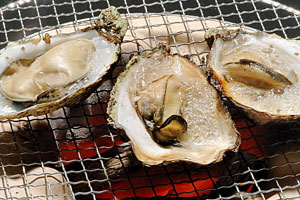
Oyster farming in Miyajima is said to have begun about 330 years ago.
Nutrients from the primeval forests of Miyajima seeping into the sea's waters are what give the Onoseto oysters their flavor.
Although there is a high-class image of the oysters, they are often eaten as takeaway from shops on Miyajima.
seasonOctober to March
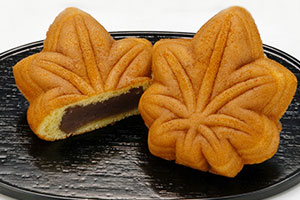
Miyajima is famous for its maple leaves, so it is only natural that its delicious sweets be named after them. Momiji manju are maple leaf-shaped, cake-like sweets filled with things like sweet bean paste. They are popular because of their sweetness.
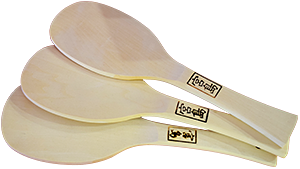
One of the most popular traditional crafts of Miyajima is the shakushi, a the wooden rice scoop which is made in the shape of a lute-like instrument called a biwa. The method for making it was conceived during the Edo period by a Buddhist priest named Seishin.
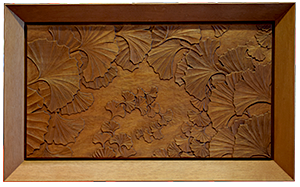
Miyajima wood carvings are made by shrine carpenters who have put their skill into daily-use objects. It is said that the trays are so straight that they would not tilt even if placed on a teacup, and that they are so well made that even spilled tea could not leave a stain.
Whether daily-use wooden crafts or lucky charms as souvenirs for visitors, all of the craft designs feature a refined simplicity.
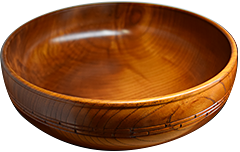
Craftsmen work to feature the natural textures of the wood used to make these trays, bowls, and cups.
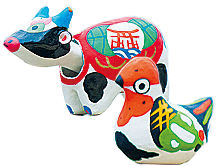
Miyajima papier-mache is made with a plaster mould that is easily shaped. There are hundreds of models, each with its own shape and color.
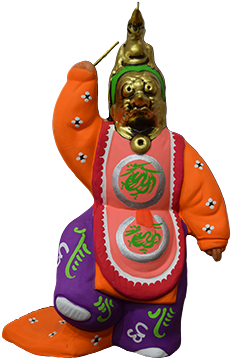
One example of Miyajima's pottery is a celebratory earthenware bell, a motif of Miyajima that produces a lovely sound.
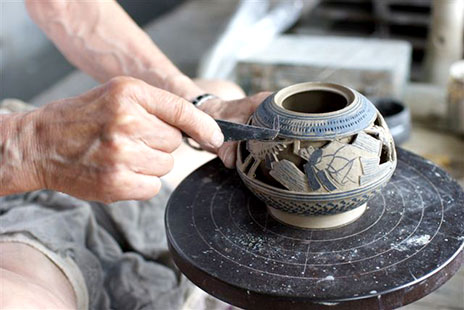
Osunayaki is made from clay mixed with sacred sand taken from under Itsukushima Shrine and blessed by priests.
Kangen-sai is a festival of entertainment for the gods, started by Taira-no-Kiyomori. Luxurious boats decorated with colorful banners and lanters float in the bay during musical gagaku performances; the scene is like something out of a Heian period picture scroll.
End of March
This festival reproduces a visit from the Heike clan to Itsukushima Shrine and is held to commemorate Taira-no-Kiyomori, who layed the foundation for Miyajima's prosperity.
venueMiyajima Pier - Itsukushima Shrine - Kiyomori Shrine
April 15th, November 15th
After burning homa prayer sticks and cypress leaves, people walk barefoot over embers while making supplications. Because the Misen Main Hall was destroyed by a typhoon in 1991, this ceremony is now held in Daishoin Temple.
venueDaiganji Temple
April 15th, October 15th
During Toka-sai and Kikka-sai sacred dancers and musicians perform on the floating High Stage of Itsukushima Shrine.
venue Itsukushima Shrine
April 16th to 18th
This is a special noh and kyogen performance for the gods on Itsukushima Shrine's noh stage. There are over four hundred performers from Hiroshima, Tokyo, and Kyoto, and an even greater number of costumes.
venue Itsukushima Shrine
June 17th
venueDaiganji Temple
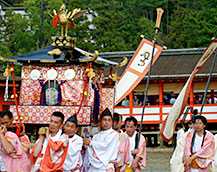
June 17th (the old lunar calendar)
Kangen-sai, the largest of the annual festivals observed at Itsukushima Shrine, takes place on the night of June 17th. Colofully decorated boats cruise down the coast carrying orchestras which play traditional gagaku music. The spectacle unfolds like a Heian period picture scroll.
venuearound Itsukushima Shrine
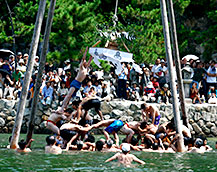
June 17 (the old lunar calendar)
Tamatori-sai is a high-energy festival that takes place in the sea. Young men living on Miyajima wrestle and fight for a wooden ball representing good luck. It is suspended from a wooden frame in front of Itukushima Shrine.
venueItsukushima Shrine
August 1st (the old lunar calendar)
Tanomosan is a harvest festival wherein small, hand-made ships called tanomo-sen are floated into the sea near Itsukushima Shrine.
venueShinomiya Shrine
December 31st
During Chinka-sai young men carry on their shoulders large, bound torches while cheering and walking along the seashore. Performed since the Edo period on the last day of the year, this is a ritual for fire prevention.
venueMikasahama